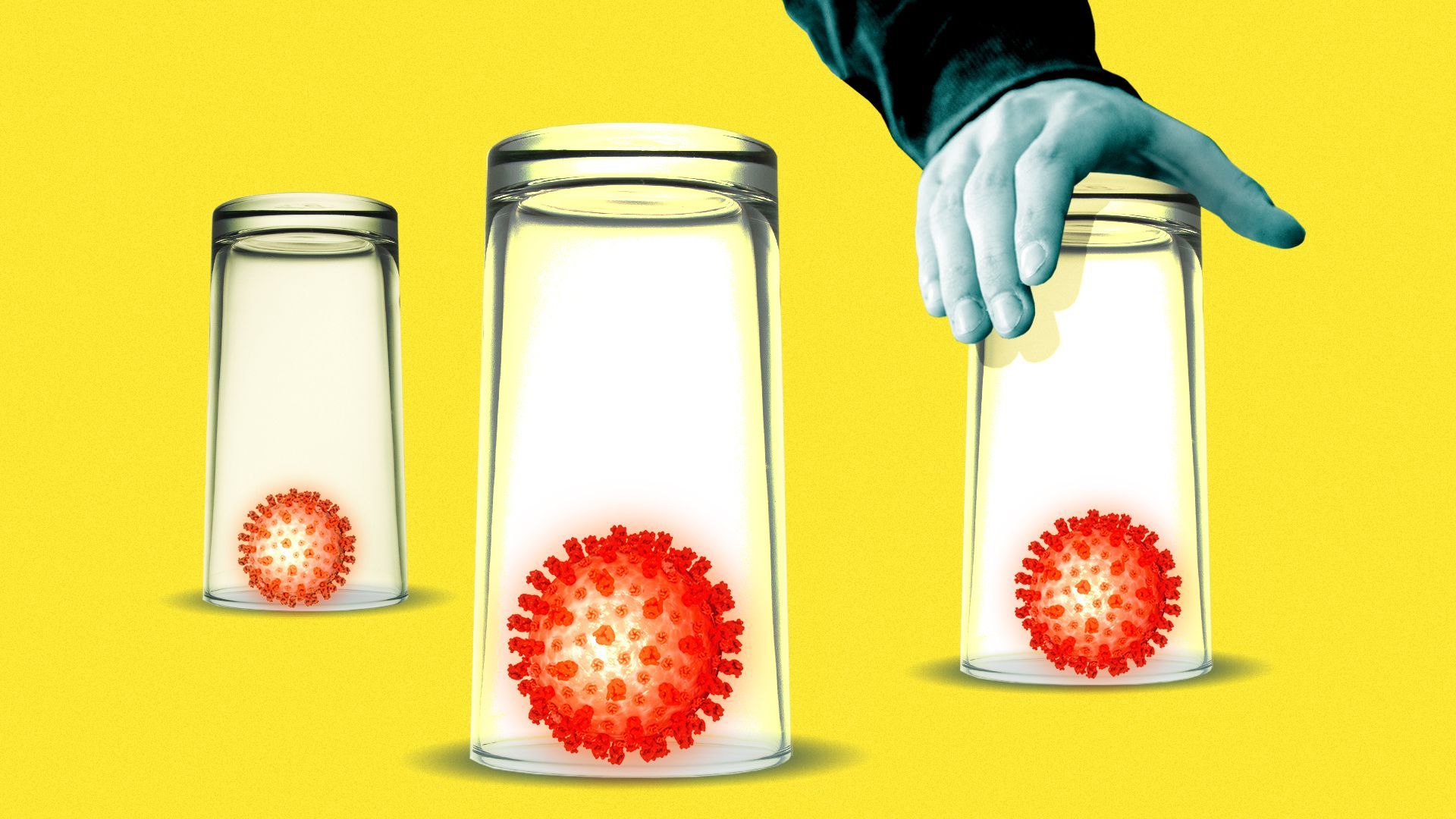| | | | | | | Presented By OurCrowd | | | | Axios Science | | By Alison Snyder ·Mar 04, 2021 | | Thanks for reading Axios Science. This week's newsletter — about pandemic preparedness, AI computer vision and how frogs solve the frog cocktail party problem — is 1,607 words, a 6-minute read. | | | | | | 1 big thing: Trapping the next pandemic |  | | | Illustration: Annelise Capossela/Axios | | | | Now that COVID-19 vaccines are bringing hope to fighting the pandemic, there is some concern the U.S. and others will lose interest in improving the tools needed to confront emerging outbreaks, Axios' Eileen Drage O'Reilly writes. The big picture: On top of the coronavirus pandemic, there are currently other smaller outbreaks around the globe — some with pandemic potential. These, and the threat of viruses emerging in the future, mean more permanent pandemic preparedness is needed, experts tell Axios. Long term, the U.S. and other nations need to continue building a better national and global network for surveillance, transparency and coordinated responses, Jennifer Nuzzo of Johns Hopkins Center for Health Security and CRDF Global's Julie Fischer tell Axios. 1) Surveillance is key, particularly as 70% of newly emerging diseases originate from animals transmitting a pathogen to a human. - This includes developing systematic genomic sequencing such as in the U.K. and Denmark, Fischer says. Right now, genomic sequencing is mostly done by academics, but a broader system could offer the state and federal governments key info, including common issues like foodborne illnesses, she adds.
- Diagnostics, such as CRISPR tools under development, also need to be faster, cheaper and easily accessible.
- Contact tracing is key to halting outbreaks without killing the economy with public lockdowns, Nuzzo says, and can be used for various outbreaks, like measles.
2) Transparency can make a difference between an outbreak and a pandemic. - The WHO depends on national surveillance programs to report outbreaks to them, but some say a stronger network is needed. Proposals include an international treaty on pandemics, a Global Immunological Observatory and financial incentives to report outbreaks earlier via World Bank programs.
- "There's a lot of incentives for countries not to report if they think that they can contain whatever the event is and they think the risks of reporting are potentially damaging to their economies ... until the point when it's inevitable that others will find out," Fischer says.
3) Fostering an agile and larger health care workforce. - "You have to be ready to understand how to surge by having people who are multiply trained, who can back each other up, who can shift tasks around so that people with the expertise that is not replaceable can be freed up to investigate the next crisis as it's happening," Fischer says.
- Nuzzo agrees that a "fundamental bottleneck is not having enough people to do it all," including the task of reviewing and acting upon a greater amount of surveillance data as that network improves.
What to watch: Whether the pandemic experience of the last year translates to more permanent preparedness. - Everyone is now "very sensitized to the impact of emerging diseases that can happen and the need to develop systems at a local level that are agile enough to respond to outbreaks when they happen," Fischer says.
|     | | | | | | 2. Outbreaks around the world |  Besides trying to stamp out the current COVID-19 pandemic, public health officials are warily watching several other hotspots around the globe, Eileen writes. Driving the news: Guinea and the Democratic Republic of the Congo are grappling with a new Ebola outbreak. They notified the WHO quickly and rapidly moved to try to contain it with a vaccination program, contact tracing and quarantining. Neighboring countries are vowing cross-border collaboration. - Russia notified the WHO on Feb. 18 about seven people confirmed with avian influenza (H5N8), but this was months after first becoming aware of the possible outbreak on Dec. 3, the WHO said. The WHO, which is testing the samples, says these would be the first humans infected with this strain, but also notes it has not yet been reported as transmitting between humans.
- A swine influenza G4 EA H1N1 is being monitored in China. The virus hasn't passed between humans but has unique characteristics and is widespread among the pig population, giving it serious pandemic potential.
Click here for the interactive map. |     | | | | | | 3. Catch up on COVID-19 |  Data: The COVID Tracking Project, state health departments; Note: Anomalous Arkansas case data from Feb. 28 was not included in the calculated change; Map: Andrew Witherspoon/Axios "Nationwide, progress against the virus has stalled," Axios' Sam Baker and Andrew Witherspoon write. - "Where it stands: The U.S. averaged just under 65,000 new cases per day over the past week. That's essentially unchanged from the week before, ending a six-week streak of double-digit improvements."
The coronavirus vaccines aren't all the same. Axios' Caitlin Owens and I break down the differences. - Why it matters: Any of the authorized vaccines are much better than no vaccine, especially for people at high risk of severe coronavirus infections. But their differences may fuel perceptions of inequity and raise legitimate questions about the best way to use each one.
The P.1 variant of the coronavirus appears to have infected some people in Brazil who had recovered from COVID-19, Carl Zimmer reports for the NYT. - Details: "There seems to be an increasing body of evidence that suggests that most of the cases associated with the second wave are indeed sort of reinfections," Nuno Faria, a virologist at Imperial College London, said.
Orangutans and bonobos at the San Diego Zoo received an experimental COVID-19 vaccine, Natasha Daly reports for National Geographic. - The big picture: Scientists are concerned about great apes' susceptibility to the SARS-CoV-2 virus. But "there's still little known about how the virus affects animals. In many cases, the veterinary community must rely on limited data sets, learning what it can from individual cases and sporadic outbreaks in a handful of species."
|     | | | | | | A message from OurCrowd | | New tech can secure billions of previously unprotected IoT devices | | |  | | | | While more and more devices connect to the internet, billions are unprotected. NanoLock fixes that with its unique, device-level protection that blocks and reports all persistent cyberattacks. It is transforming the IoT landscape. Explore NanoLock's investment potential at OurCrowd. | | | | | | 4. Seeing like an AI |  | | | Illustration: Sarah Grillo/Axios | | | | New research from a major AI company offers insight into how neural networks are able to "see," Axios' Bryan Walsh reports. Why it matters: Reliable computer vision is a cornerstone for AI applications like self-driving cars, but the effectiveness of neural nets in recognizing images is only matched by their impenetrability. The new research allows scientists to peer into the black box of computer vision, with implications for reducing bias and errors. Driving the news: In a new paper about its CLARITY project, researchers from OpenAI show that "multimodal" neurons are at work within the artificial neural network of its CLIP general-purpose vision system, which is capable of recognizing images and writing text descriptions. - Multimodal refers to a single neuron firing in response to certain photographs, sketches and even text — all different "modes" of representation — that can be classified under a single concept, like "my grandmother," or in the case of one famous neuroscience paper from 2005, the actress Halle Berry.
How it works: A majority of the artificial neurons at work in the CLIP model show evidence of this multimodality, according to Gabriel Goh, the lead researcher for OpenAI on CLARITY. - The same neuron that fires for an image of a spider might fire for text that contains the word "spider," or even for certain patches of red and blue that CLIP can recognize from the comic book character Spiderman.
- "Both the brain and these kinds of synthetic vision systems seem to be converging on a very similar kind of mode of organizing information," says Goh. "So it may turn out that these systems aren't as much of a black box as we thought."
The big picture: Beyond providing insight into how computer vision systems actually work, the CLARITY research can help AI scientists identify how those systems might be biased or even deliberately disrupted, says Ilya Sutskever, co-founder and chief scientist at OpenAI. |     | | | | | | 5. Worthy of your time |  | | | Illustration: Aïda Amer/Axios | | | | We're starting to take the Sun seriously (Miriam Kramer — Axios) The essential fly (Stephanie Pain — Knowable) The race to teach sign language to computers (Economist) Bonus: It's March Mammal Madness time |     | | | | | | 6. Something wondrous |  | | | Credit: Norman Lee/St. Olaf College | | | | To find a mate, female green tree frogs have to sift through a cacophony of calls from other frog species. Their lungs appear to assist them by operating like noise-canceling headphones, researchers report today. The big picture: Evolution often addresses a problem "in some interesting way hundreds of millions of years before a human engineer ever thought to solve that problem," says Mark Bee of the University of Minnesota, who is a co-author of the research. The basics: Unlike humans, the ears of most frog species are coupled to one another through the animal's mouth cavity, and their eardrums can sense vibrations from the mouth and lungs. (Next time you look in a frog mouth, see if you can spot the two gaping holes that go to their ears.) - Researchers thought vibrations from the lungs to the ears helped frogs figure out the direction a sound was coming from.
- But the new research suggests female tree frog lungs are instead helping them to dampen the noise of other species so they can tune in to potential mates — and tune out distractors.
What they did: Norman Lee of St. Olaf College, Bee and their collaborators placed American green tree frogs (Hyla cinerea) in a room with speakers and played sounds with a range of frequencies for them. - The frogs' lungs were deflated (by pressing gently on the animals' sides) or inflated (through a tube that they put in the frog's mouth and Lee breathed into).
- A reflective bead was placed on the frog's eardrum, which the researchers then pointed a laser at to measure how the eardrums vibrated when they heard different frequency sounds.
What they found: When the frogs' lungs were inflated, the eardrums' response to sounds with frequencies similar to their own species didn't change. - But they were less sensitive to frequencies within the range of vocalizations from other species, the researchers report today in the journal Current Biology.
- The researchers think the lungs may be functioning like noise-canceling headphones, which use microphones to record ambient noise and then play an opposite "anti-phase" signal that cancels out the noise.
What to watch: An increase in noise generated by humans and our activities has spurred studies of the effect of our sounds on animals. - But most of that research focuses on how noise impacts the behavior of animals producing the signals (are they louder or different?) rather than those hearing it, says Bee.
- "That research could be broadened to seriously consider adaptations that allow animals to hear in noise."
|     | | | | | | A message from OurCrowd | | OurCrowd breaks down private market barriers for investors | | |  | | | | The challenge: Startups are staying private longer, keeping investment growth behind closed doors. The solution: OurCrowd is changing that. They have 73K members and have invested $1B+ in companies like Lemonade and Beyond Meat — pre-IPO. Get in early on tomorrow's big deal - with OurCrowd. | | | | | | Axios thanks our partners for supporting our newsletters.
Sponsorship has no influence on editorial content. Axios, 3100 Clarendon Blvd, Suite 1300, Arlington VA 22201 | | | You received this email because you signed up for newsletters from Axios.
Change your preferences or unsubscribe here. | | | Was this email forwarded to you?
Sign up now to get Axios in your inbox. | | | | Follow Axios on social media:    | | | | | |









No comments:
Post a Comment